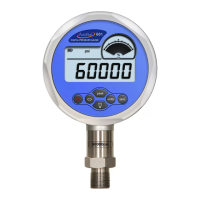
Do you have a question about the Additel ADT681 and is the answer not in the manual?
| Brand | Additel |
|---|---|
| Model | ADT681 |
| Category | Measuring Instruments |
| Language | English |
Discusses the ADT681's purpose, features, power, and data logging capabilities.
Mentions EMC testing, European CE, ATEX, and CSA intrinsic safety certifications.
Lists various gauge pressure ranges, accuracy, and burst pressure for different models.
Details specifications for compound pressure ranges, including accuracy and burst pressure.
Lists specifications for absolute pressure ranges, accuracy, and burst pressure.
Provides specifications for differential pressure ranges, accuracy, and burst pressure.
Covers instrument types, pressure units, overpressure, measuring speed, and environmental conditions.
Outlines features like temperature compensation, display, battery life, power, serial communication, dimensions, and weight.
Describes temperature measurement, peak recording, pressure percentage, and fluctuation indication.
Provides initial usage instructions and a warning for low battery voltage.
Details safety warnings for use in hazardous environments, including battery handling and case integrity.
Lists CSA markings and special conditions for safe installation and use.
Identifies and labels the main components of the ADT681 on its front and back views.
Explains the primary functions of each button on the keypad.
Describes how to input data using the keypad buttons and navigation.
Details the various elements displayed on the ADT681 screen.
Guides users on navigating menus and inputting coefficients.
Provides specific definitions for icons like the battery status and pressure unit display.
Instructs on how to turn the ADT681 on and off using the power button.
Explains how to return to the home screen and the content displayed during pressure measurement.
Details the procedure for zeroing both gauge and absolute sensor types.
Guides on switching between different pressure units and provides a conversion table.
Explains how to view and reset the maximum and minimum pressure values recorded.
Describes how to turn the backlight on/off and set auto-off timers.
Details the three types of indications available on the analog dial.
Explains the percentage indication on the analog dial and its components.
Describes the pressure swing indication and how it's displayed.
Explains the icon that indicates an overpressure condition.
Details how to set the high and low alarm limits for pressure.
Guides on how to enter the temperature measurement mode and its specifications.
Covers setting up date/time, logging interval, and starting/stopping data logging.
Explains how to export logged data using the Additel/Land software.
Describes how to access the device's menu system using password entry.
Describes how to access the device's menu system using password entry.
Lists the 12 available options within the device's menu system.
Details menu options for calibration entry, cancellation, and previous zeroing.
Explains how to set the measurement speed and apply digital filtering.
Covers setting the RS232 address and baud rate for communication.
Describes settings for automatic shutdown and choosing between 4 or 5-digit display.
Explains how to set custom unit factors and use the tare function.
Details the steps for performing a single-point calibration.
Specifies the environmental and equipment conditions needed for calibration.
Outlines the procedure for calibrating single and dual scale gauges.
Explains how to cancel an ongoing calibration.
Illustrates connecting the DC9V adapter for the standard type.
Shows the battery installation procedure for the intrinsically safe type.
Provides crucial warnings regarding battery replacement, especially in hazardous areas.
Details the battery life in low power mode at different measure speeds.
Enumerate the items that come with the ADT681.
Gives the address, phone number, and email for customer support.
Describes the format for data sent from a PC to the ADT681.
Details the format of data returned by the ADT681 to a PC.
Lists and explains the codes used for error reporting.
Explains serial port settings like address, baud rate, data length, stop bit, parity, and flow control.
Provides a detailed table of commands, their parameters, and return values.
Lists abbreviations for various pressure units.
Explains the binary codes used to represent selectable pressure units.
Describes the format and length of automatically transmitted data.